Can Vitamin Deficiency Cause Nails To Split And Blood Pressure To Go Low
Unless otherwise stated, all treatments and doses are for adults and non weight based for the pediatric population.
Instance Case:
A 48-year-onetime female person patient presents to your dispensary for abnormal findings in her toes. She knows that the summer season is coming up and the aberrant advent of her toenails is very concerning to her. She is a regular patient to your dispensary, routinely seen for type 2 diabetes mellitus that is poorly controlled.
Allow'southward review some anatomy(Scher RK)
If you were to look at the cross section of your digit, you lot would come across that the nail bed is covered by the nail plate. The near proximal portion of the nail bed is the blood supply and the growth region, called the boom matrix, which provides the epithelial cells for nail plate growth. When information technology comes to the conditions discussed in this review, damage to the matrix is key in causing many of the irregularities experienced: longitudinal lines, roughness, pitting, brittleness, and transverse lines. Overlying the blast on the proximal end is the cuticle (skin). On either side (lateral) of the boom are the nail folds. Just below the blast bed is the distal phalanx and periosteum. Due to the close proximity, any condition that affects the bone tin affect the nail, and vice versa.
Important Atmospheric condition Associated with Abnormal Smash Exam
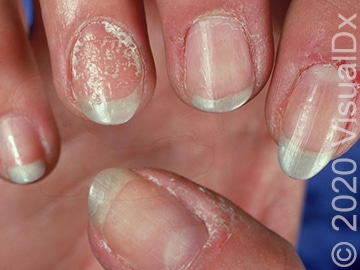
Psoriasis
Tin manifest with nail pitting, leukonychia, and an oil drop sign on the blast bed. Expect for cutaneous psoriasis as a coexisting feature.
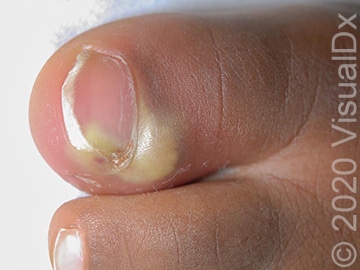
Paronychia
Tin nowadays acutely or in a chronic way with tender, erythematous swelling and folding on the lateral portions of the blast. Treat with warm saline soaks and, if a concurrent abscess is nowadays, possible drainage with antibiotics targeted toStaphylococcus aureus(if acute) and gram negatives with Candida(if chronic). (Rigopoulos D, 2008)
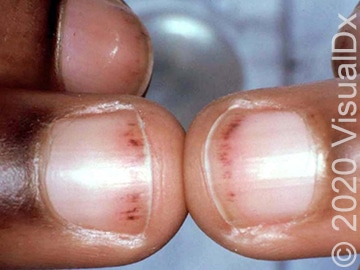
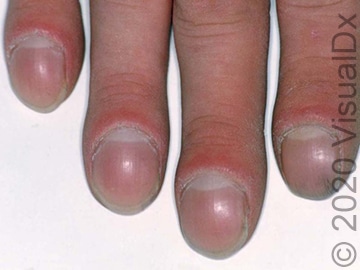
Clubbing
Classically associated with severe pulmonary illness (COPD, lung cancer) causing hypertension and a chronic state of hypoxia; can as well be associated with inflammatory bowel disease. Look for painless bilateral enlargement of the nail fold angles of all fingers and toes and a positive Schamroth sign. Consider testing HIV, TSH, LFTs, and CBC. Treatment is centered on the underlying crusade. (Chumley HS)
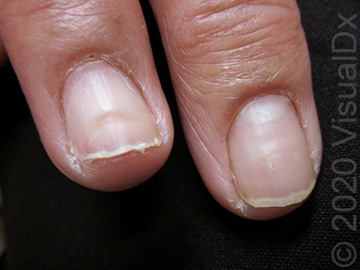
Beau Lines
Presents every bit transverse grooves or furrows in the nail. Generalized causes include medication side effects (ie, retinoids for acne), liver/cardiac/renal failure, carpal tunnel if present on just i extremity, postsurgical complexity from tourniquet use, and regional pain syndrome. If only one or a few digits are involved, manus-human foot-and-mouth illness should be considered. (LeBlond RF)
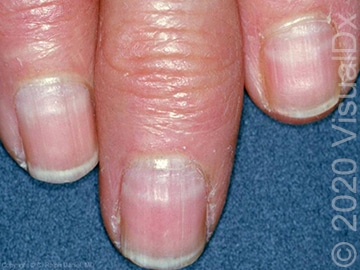
Mees' Lines
Besides known as transverse white nail lines, can exist seen during periods of stress, renal failure (acute), heart failure, inflammatory bowel disease, SLE, and malignancy. In the correct clinical setting, consider toxic metal exposure (ie, thallium). (Lipner SR, 2016)
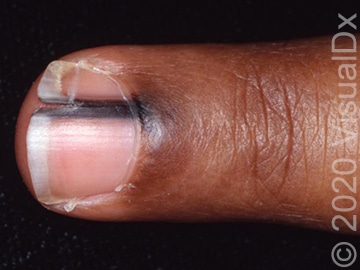
Hutchinson Sign
Melanoma in situ manifesting as a pigmented linear line (brown to black) from the matrix to the perionychium and typically a poor prognostic indicator as information technology could represent radial-growth phase melanoma. Such bands, which typically accept a sudden onset and growth, oftentimes affect only a unmarried digit (commonly the thumb). Such patients, who are typically in their 60-80s with a family history of melanoma, should be referred to a dermatologist for dermoscopy to be performed with biopsy. (Lipner SR, 2016)
Is there a structured style to arroyo nail conditions?
The easiest way to arroyo the differentials is past splitting them into two categories: localized nail conditions and systemic, which tin can be a harbinger for another underlying status. Side by side, when dealing with localized conditions, understanding the anatomy of the blast bed tin can farther assistance distinguish conditions. Another manner to look at these conditions is past determining what part of the matrix is involved.
How to approach the history and exam
Knowing the anatomy to a higher place is crucial. Furthermore, patients should be instructed, ideally by your staff prior to their visit (if in the outpatient setting), to remove whatsoever nail polish present. If you would like to document changes over fourth dimension, employ your local hospital or clinic policy for taking photographs to include in the clinical record. Understand that regardless of sexual activity, race, or ethnicity, the nail bed color is identical. Therefore, any preserved discoloration may be pathological or physiologic and should not exist attributed to normal variants. (Jefferson J).
The following social and familial historical elements are helpful in creating a differential diagnosis:
- Occupation
- Exposures to topical substances
- Medication history
- Smoking or tar use
- Illicit drug history
- Family history of similar findings/concerns
When it comes to the specific complaint, it is important to know the following information:
- How many digits are affected and whether the condition spread or affected all digits at once
- History of trauma to the affected digits
- Whatever recent stress
- Whether or non all the nails appear similar
Are all abnormal appearances to the nail suggestive of illness?(Mayeaux)
No; There are normal nail variants that every clinician should be enlightened of (see table beneath for those that may be associated with underlying systemic disease). Many times, these variants are associated with a disruption in smash formation. Many patients think that abnormalities in the nails, even if they are normal variants, are suggestive of an underlying vitamin deficiency. It is important to reassure these patients as to which findings are apropos based on your test and which are non.
- Transverse striate leukonychia – Also known as transverse white streaks, these tin can be seen in a healthy patient and are not suggestive of underlying pathology. The all-time way to distinguish these is by looking at the lateral most portion of the blast, as these streaks will not extend to the lateral nigh portion of the fold.
- Smash hypertrophy – Development of opaque thickened nails, also called ram'due south horn nail, that tin occur with age, fungal infections, and trauma. Typically asymptomatic; all the same, pain may occur if pressure is placed directly onto the smash.
- Habit-tic deformity – Habitual picking of the proximal nail fold can result in secondary inflammation and harm to the smash plate, leading to a ridged advent.
- Fellow lines – Discussed extensively above and below, can occur with trauma or severe illness when of pathologic origin.
- Lindsay nails – Also known as half-and-half nail, the proximal portion of the nail is white and the distal portion is pink, with a abrupt demarcating line between the ii halves. Tin exist seen likewise in patients with cirrhosis and HIV.
Is this a vitamin problem?(Seshadri D, 2012)
The nail itself requires myriad nutrients to stay salubrious. About vitamin deficiencies are due to either inadequate dietary intake or malabsorption. Vitamin D, which tin be obtained through sun exposure, is 1 of the few exceptions. Lack of these nutrients may affect the boom, the nail bed, or both and may nowadays on physical exam or with biopsy. Common weather we experience in the master care setting, such as iron deficiency and magnesium deficiencies in patients with booze use disorder, tin affect their concentrations, or lack thereof, in the nail. Below, we volition talk over common blast findings associated with malnutrition and vitamin/mineral deficiencies.
Diet deficiencies
- Beau lines – Associated with protein deficiencies in patients with chronic alcohol use disorder. Present equally transverse depressions in a linear fashion of the boom due to disruption in the growth of the nail.
- Terry nails – Seen in those with cirrhosis and malnutrition. When looking at the proximal nail bed, it will appear as a pink or chocolate-brown band.
- Muehrcke lines (Pfeiffer C, 1974) – Patients with chronically depression albumin and/or zinc levels may develop this exam finding; correction of albumin levels (< two.2 g/mL) will lead to resolution of the findings. Await for narrow, white transverse linear bands that disappear if you press downwards on the distal portion of the nail.
- Brittle nail syndrome – Those who are chronically malnourished tin develop brittle nail syndrome, which presents with soft, weak, and easily breakable nails that form longitudinal splits. In your younger patients who present with this, ask about matted eating habits that may reveal underlying anorexia. In your elderly patients, this may be a sign of dementia.
Vitamin and mineral deficiencies
- Fe deficiency(Ghaffari Due south, 2018) (Adhikari, 2018) – Normally seen in the primary care setting, iron deficiency can cause koilonychias, presenting every bit a reverse curvature of the blast bed due to the furnishings that a lack of iron has on the distal matrix. This isolated effect on the distal, rather than proximal, matrix causes the nail to abound in a downwards direction. In post-gastrectomy patients who are at risk for malabsorption, remember that koilonychias may be a sign of deficiencies if routine testing (CBC with mean corpuscular volume [MCV] level) are not abnormal.
- Selenium deficiency (Hasunuma North, 2014) (Tonelli M, 2015) – Found in poultry, milk, wheat, and potatoes, selenium is by and large obtained through plants due to its presence in the soil. Deficiency tin can be seen in vegetarians who consume food where the soil is scarce in selenium. In first world countries, can be observed in those on both hemodialysis and peritoneal dialysis or inflammatory bowel disease. On exam, await for opaque, whitened boom beds.
- Calcium deficiency (al., 2015) – Transverse white bands forth multiple nails in the relatively same position tin occur with calcium deficiencies, but they are reversible with handling. Measuring the altitude from the nail fold can assistance estimate the duration of symptoms (the growth rate is 1 mm/calendar month in the toes and 3 mm/month in the fingers). Ultimate cause is unclear but may exist associated with arterial spasm and ischemia.
- Vitamin C deficiency (DiBaise Thousand, 2019) (PJ, 2011) (Rollier R, 1955) (NIH, 2018) – First diagnosed by James Lind in sailors who were at ocean for long periods of fourth dimension in the 1700s, scurvy is associated with a deficiency in vitamin C, either due to diet (rare) or more ordinarily malabsorption, second-hand smoke exposure, and alcohol utilise disorder. Due to the importance of vitamin C for collagen production, the deficiency manifests every bit brittle nails, koilonychias, and splinter hemorrhages. Other than boom findings, classically patients will have gingival inflammation with corkscrew hairs and loose teeth.
- Zinc deficiency (Pfeiffer C, 1974) (Morgan Z, 2011) – Can appear as white, opaque spots on the nail, more unremarkably in the alphabetize or 5th digits of the ascendant paw. As mentioned in a higher place, these are also chosen Muehrcke lines, as they may be associated with low albumin levels.
- Fat-soluble vitamin deficiency (al. S. Thousand., 2011) – Deficiencies specifically in vitamins A, D, E, and K typically will cause nails to exist softer, termed hapalonychia. Yellow discoloration of the nails, not to be confused with onychomycosis, tin can occur with vitamin E deficiencies. Warn patients that those fatty-soluble vitamins tin be toxic if taken in larger than recommended amounts, every bit these vitamins are stored in the liver and adipose tissue.
- Water-soluble vitamin deficiency (Yiping Chiliad, 2014) (Cakmak SK, 2006) (Staggs CG, 2004) (Supplements., 2018) – The majority of water-soluble vitamins that, when deficient, present with abnormal nail findings, center around the B circuitous of vitamins. Koilonychia, every bit presented higher up, tin can occur with Vitamin B2 and B3 deficiency in particular. While these can exist due to nutrient deficiencies from a diet defective in dairy (recollect lactose intolerance), they can also occur from medications affecting their absorption (ie, nicotinamide or isoniazid therapy). Other than koilonychia, look for dermatologic manifestations of cheilitis, aphthous ulcers, and pharyngitis.
- Vitamin B3 deficiency, too known every bit pellagra, occurs with poor intake of poultry, nuts, seeds, legumes, and beefiness. Depression levels can lead to a unique finding of half-and-one-half blast due to melanin deposition. Remember the 4 "D'due south" of pellagra: dermatitis (hyperpigmented rash on sunday-exposed regions), diarrhea, dementia, and death. Patients with this finding should exist evaluated for renal failure, which commonly coexists. In full general, it is rare to develop toxic levels of water-soluble vitamins, equally those in excess are excreted in the urine.
- Finally, the most mutual deficiency to cause boom manifestations isbiotin deficiency. While systemic signs of alopecia, myalgias, and paresthesias, brittle nails can develop through dietary lack of eggs, meat, fish, sunflower seeds, and peanuts. Other than nutrient deficiencies, they can exist seen in patients who accept malabsorptive diseases and booze use disorder.
Blast Conditions past Matrix Involvement (Richert, 2015) | ||||||
Proximal Matrix | ||||||
| Longitudinal Ridging Presents as shallow ridges, which can be physiologic (if multiple are noted) or associated with trauma (when a single ridge is present) and become more apparent as we age. When pathologic, associated with rheumatoid arthritis and peripheral vascular illness. (Michel C, 1997) | Longitudinal Grooves Longitudinal Grooves – Too called Beau lines or transverse lines, nowadays equally depressions in office or the entirety of the nail affecting ane or all of the nails. When multiple fissures are noted, termed onychorrhexis. Mucoid cysts may be nowadays if a single smoothen gutter is noted. | Pitting Small depressions on the surface of the nail that vary in size and shape with no clear pattern of distribution. Near unremarkably nowadays on the toenails, wait for other dermatologic manifestations that may suggest underlying psoriasis (typically simply seen with > 20 pits on nails), atopic dermatitis, alopecia, or lichen planus. | ||||
Distal Matrix | ||||||
| Leukonychia Nail volition appear white due to abnormal keratinization of the nail matrix. May nowadays in a half-and-half appearance that goes away with distal pressure level. Myriad causes, some associated with trauma (preceded past subungual hematoma); if the lines are transverse (termed Mees' lines), look for atypical causes such as arsenic poisoning, parasitic infections, and reactions to chemotherapy. | Erythronychia Ruby discoloration of the nail matrix that disappears with pressure and is associated with systemic conditions such as psoriasis, lichen planus, and alopecia areata. | Melanonychia Melanin deposited in the boom plate showing up every bit bands. The color can vary. | ||||
What nail findings are seen with increasing age?
While many nail findings tin can be physiologic, due to deficiencies in either vitamins or minerals, or associated with systemic disorders, there are others that occur with increasing frequency simply due to progressing age. Examples include brittle nails, onychocryptosis, onychomycosis, and subungual hematomas.

Breakable nail syndrome
As its name implies, patients will experience splitting of the nails on the free edge at the distal region of the nail. Oral biotin supplementation can be helpful. Have the patient avoid topical cosmetics and repetitive trauma, if possible.
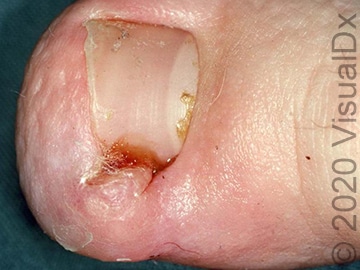
Onychocryptosis
May await similar to paronychia; look for inflammation of the lateral nail fold. Conservative handling with partial removal of the affected smash portion is helpful. Preventive measures include education appropriate boom cutting technique and evaluating shoes to ensure they are not too small of a fit. (Martínez-Nova A, 2007)

Onychauxis
Hypertrophy of the nail leading to shrinkage and discoloration. Tin can be painful and may be hard to distinguish from concurrent onychomycosis. Can be due to repetitive trauma from poor shoe compatibility and chronic toe contracture.

Onychomycosis
The most common smash infection of fungal origin, most often affecting the toenails, presenting with yellow patchy discoloration with blast thickening. Increased risk seen with older historic period and smoking; there has been genetic predisposition found. Handling is targeted towardTrichophyton species, but other species such equallyCandida andScopulariopsis take been reported. Handling can be difficult and may crave boom removal with systemic therapy (oral terbinafine). (Gupta AK, 2006) In the right population, consider testing for HIV. (Surjushe A, 2007)

Subungual hematoma
Associated with trauma; await for a painful red discoloration under the boom that moves forward with time. Can exist mistaken for melanoma; therefore, if at that place is no trauma history, consider referral for biopsy. If astute hurting is noted, it responds well to pressure relief by drilling a hole (can use an 18-g needle) into the nail plate. Avoid dissentious the smash matrix.
Determination
The above patient'south diagnosis was onychomycosis, probable secondary to her poorly controlled diabetes. She was placed on an oral prescription of terbinafine, and she was followed upwardly with 2 months later on with resolution of her symptoms. If the symptoms had not improved, and so a podiatry consultation could be considered for toenail removal.
The smash is a gateway into the body and can help reveal underlying systemic conditions. It is important not to forget well-nigh nail evaluation when performing your general physical exam.
Subscribe to VisualDx Today
Go a VisualDx subscriber today and proceeds access to clinical data and medical images of thousands of diagnoses. Your starting time 30 days are Costless.
Learn More
Source: https://www.visualdx.com/blog/nailing-your-diagnosis-the-hand-exam/
Posted by: forsheeclinter.blogspot.com

0 Response to "Can Vitamin Deficiency Cause Nails To Split And Blood Pressure To Go Low"
Post a Comment